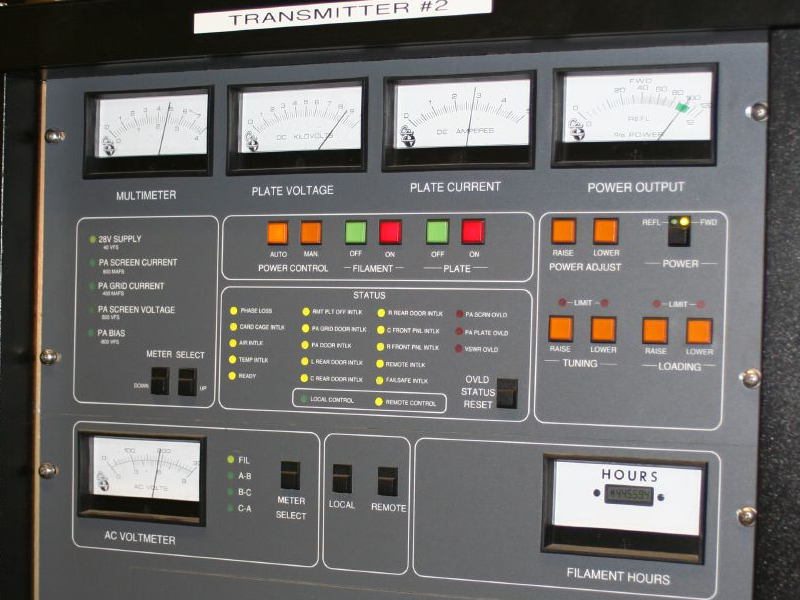|
Predistortion
Predistortion is a technique used to improve the linearity of radio transmitter amplifiers. Radio transmitter amplifiers in most telecommunications systems are required to be "linear", in that they must accurately reproduce the signal present at their input. An amplifier that compresses its input or has a non-linear input/output relationship causes the output signal to splatter onto adjacent radio frequencies. This causes interference on other radio channels. There are many different ways of specifying the linearity of a power amplifier, including P1dB, inter-modulation distortion (IMD), AM-to-PM, spectral regrowth and noise power ratio (NPR). For a truly linear system, these measures are in a sense all equivalent. That is, a power amplifier with low inter-modulation distortion will also have low spectral regrowth and low AM-to-PM distortion. Likewise there are two equivalent ways of conceptualizing how predistortion amplifiers work: correcting gain and phase distortions, or cancel ... [...More Info...] [...Related Items...] OR: [Wikipedia] [Google] [Baidu] |
Digital Pre-distortion
Multidimensional digital pre-distortion (MDDPD), often referred to as multiband digital pre-distortion (MBDPD), is a subset of digital predistortion (DPD) that enables DPD to be applied to signals (channels) that cannot or do not pass through the same digital pre-distorter but do concurrently pass through the same nonlinear system. Its ability to do so comes from the portion of multidimensional signal theory that deals with one dimensional discrete time vector input - 1-D discrete time vector output systems. The first paper in which it found application was in 1991 as seen here. None of the applications of MDDPD are able to make use of the linear shift invariant (LSI) system properties as by definition they are nonlinear and not shift-invariant although they are often approximated as shift-invariant (memoryless). Motivation Although MDDPD enables the use of DPD in multi source systems, there is another advantage from implementing MDDPD over DPD which is the prime motivation of the i ... [...More Info...] [...Related Items...] OR: [Wikipedia] [Google] [Baidu] |
Radio Transmitter
In electronics and telecommunications, a radio transmitter or just transmitter (often abbreviated as XMTR or TX in technical documents) is an electronic device which produces radio waves with an antenna with the purpose of signal transmission to a radio receiver. The transmitter itself generates a radio frequency alternating current, which is applied to the antenna. When excited by this alternating current, the antenna radiates radio waves. Transmitters are necessary component parts of all electronic devices that communicate by radio, such as radio (audio) and television broadcasting stations, cell phones, walkie-talkies, wireless computer networks, Bluetooth enabled devices, garage door openers, two-way radios in aircraft, ships, spacecraft, radar sets and navigational beacons. The term ''transmitter'' is usually limited to equipment that generates radio waves for communication purposes; or radiolocation, such as radar and navigational transmitters. Generators of radio ... [...More Info...] [...Related Items...] OR: [Wikipedia] [Google] [Baidu] |
Amplifier
An amplifier, electronic amplifier or (informally) amp is an electronic device that can increase the magnitude of a signal (a time-varying voltage or current). It is a two-port electronic circuit that uses electric power from a power supply to increase the amplitude (magnitude of the voltage or current) of a signal applied to its input terminals, producing a proportionally greater amplitude signal at its output. The amount of amplification provided by an amplifier is measured by its gain: the ratio of output voltage, current, or power to input. An amplifier is defined as a circuit that has a power gain greater than one. An amplifier can be either a separate piece of equipment or an electrical circuit contained within another device. Amplification is fundamental to modern electronics, and amplifiers are widely used in almost all electronic equipment. Amplifiers can be categorized in different ways. One is by the frequency of the electronic signal being amplified. For ... [...More Info...] [...Related Items...] OR: [Wikipedia] [Google] [Baidu] |
Spectral Regrowth
Spectral regrowth is the intermodulation Intermodulation (IM) or intermodulation distortion (IMD) is the amplitude modulation of Signal (electrical engineering), signals containing two or more different frequencies, caused by non-linear, nonlinearities or time variance in a system. ... products generated in the presence of a digital transmitter added to an analog communication system. References Radio electronics {{electronics-stub ... [...More Info...] [...Related Items...] OR: [Wikipedia] [Google] [Baidu] |
Linearizer
In signal processing, linearizers are electronic circuits which improve the non-linear behaviour of amplifiers to increase efficiency and maximum output power. Creating circuits with the inverted behaviour to the amplifier is one way to implement this concept. These circuits counteract the non-linearities of the amplifier and minimize the distortion of the signal. This increases linear operating range up to the saturation (maximum output power) of the amplifier. Linearized amplifiers have a significantly higher efficiency with improved signal quality. There are different concepts to linearize an amplifier, including pre- and post-distortion and feedback linearization. Most commonly used is pre-distortion linearization. The function performed by the linearizer in relation to the amplifier is very similar to that of eyeglasses in relation to the eye. The eye distorts the image seen; the glasses pre-distort the image. When these two distortions are combined, the result is a clear ... [...More Info...] [...Related Items...] OR: [Wikipedia] [Google] [Baidu] |



